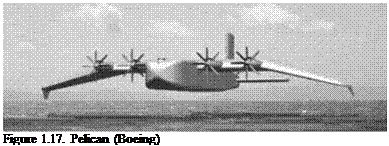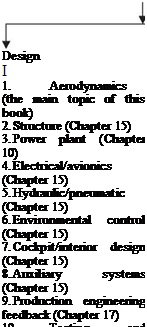This extended section of the book can be found on the Web at www. cambridge .org/Kundu and gives a brief overview of near-future military-aircraft design trends, covering typical, new, and emerging operational roles (e. g., UAVs and design challenges). Figures 1.18 and 1.19 are associated with the section.
Figure 1.18. JUCAS prototypes (X47B)

Figure 1.19. Future design type
1.3
Learning Process
To meet the objectives of offering close-to-industrial practice in this book, it is appropriate to reiterate and expand on remarks made in the preface about the recognized gap between academia and the industry. It is impertinent to explain the aircraft-design process before outlining the intended classroom learning process. The methodology suggested herein is the same as what I experienced in industry.
It is clear that unless an engineer has sufficient analytical ability, it will be impossible for him or her to convert creative ideas to a profitable product. Today’s innovators who have no analytical and practical skills must depend on engineers to accomplish routine tasks under professional investigation and analysis and to make necessary decisions to develop a marketable product.
Traditionally, universities develop analytical abilities by offering the fundamentals of engineering science. Courses are structured with all the material available in textbooks or notes; problem assignments are straightforward with unique answers. This may be termed a “closed-form” education. Closed-form problems are easy to grade and a teacher’s knowledge is not challenged (relatively). Conversely, industry requires the tackling of “open-form” problems for which there is no single answer. The best solution is the result of interdisciplinary interaction of concurrent engineering within design built teams (DBTs), in which Total Quality Management (TQM) is needed to introduce “customer-driven” products at the best value. Offering open-ended courses in design education that cover industrial requirements is more difficult and will challenge a teacher, especially when industrial experience is lacking. The associative features of closed – and open-form education are shown in Figure 1.20 ([9] and [10]).
To meet industry’s needs, newly graduated engineers need a brief transition before they can become productive, in line with the specialized tasks assigned to them. They must have a good grasp of the mathematics and engineering sciences necessary for analysis and sufficient experience for decision making. They must be capable of working under minimal supervision with the creative synthesis that comes from experience that academia cannot offer. The industrial environment will require new recruits to work in a team, with an appreciation of time, cost, and quality under TQM – which is quite different from classroom experience.
The purpose of my book is to provide in the coursework close-to-industry standard computations and engineering approaches sciences necessary for analysis and
Figure 1.21. Typical CAD drawing of Airbus A400
 enough experience to work on a team. The level of mathematics in this book is not advanced but contains much technological information.
enough experience to work on a team. The level of mathematics in this book is not advanced but contains much technological information.
Here, I compare what can be achieved in about 36 hours of classroom lectures plus 60 hours by each of about 30 inexperienced students to what is accomplished by 20 experienced engineers each contributing 800 hours («6 months). Once the task was clearly defined shadowing industrial procedures, leaving out multiple iterations, I found that a reduced workload is possible in a classroom environment. It cuts down manhour content, especially when iterations are minimized to an acceptable level. My goal is to offer inexperienced students a powerful analytical capability without underestimating the importance of innovation and decision making.
For this reason, I emphasize that introductory classwork projects should be familiar to students so that they can relate to the examples and subsequently substantiate their work with an existing type. Working on an unfamiliar nonexistent design does not enhance the learning process at the introductory level.
Although it is not essential for the classwork, I highly recommend that modern conceptual aircraft designers be conversant with 3D modeling in CAD (Figure 1.21 is a CAD drawing example) (most recent graduates are). The 3D modeling provides fuller, more accurate shapes that are easy to modify, and it facilitates maintenance of sequential configurations – benefits that become evident as one starts to configure.
There are considerably more benefits from CAD (3D) solid modeling: It can be uploaded directly into CFD analysis to continue with aerodynamic estimations, as one of the first tasks is to estimate loading (CFD) for structural analysis using the FEM. The solid model offers accurate surface constraints for generating internal structural parts. CAD drawings can be uploaded directly to computer-aided manufacture (CAM) operations, ultimately leading to paperless design and manufacture offices (see Chapter 17). Today’s conceptual aircraft designers must master many trades and specialize in at least one, not ignoring the state-of-the-art “rules of thumb” gained from past experience; there is no substitute. They need to be good “number-crunchers” with relatively good analytical ability. They also need assistance from an equally good support team to encompass wider areas. Vastly
increased computer power has reached the desktop with parallel processing. CAE (e. g., CAD, CAM, CFD, FEM, and systems analyses) is the accepted practice in the industry. Those who can afford supercomputers will have the capability to conduct research in areas hitherto not explored or facing limitations (e. g., high-end CFD, FEM, and multidisciplinary optimization [MDO]). This book is not about CAE; rather, it provides readers with the basics of aircraft design that are in practice in the industry and that would prepare them to use CAD/CAE.
Finally, I recommend that aircraft designers have some flying experience, which is most helpful in understanding the flying qualities of aircraft they are trying to design. Obtaining a license requires effort and financial resources, but even a few hours of planned flight experience would be instructive. One may plan and discuss with the flight instructor what needs to be demonstrated – that is, aircraft characteristics in response to control input, stalling, “g” force in steep maneuvers, stick forces, and so forth. Some universities offer a few hours of flight tests as an integral part of aeronautical engineering courses; however, I suggest even more: hands-on experience under the supervision of a flight instructor. A driver with a good knowledge of the design features has more appreciation for the automobile.












 Manpower
Manpower Customer
Customer




 Chapter introduction
Chapter introduction

 enough experience to work on a team. The level of mathematics in this book is not advanced but contains much technological information.
enough experience to work on a team. The level of mathematics in this book is not advanced but contains much technological information.